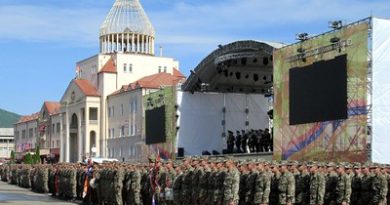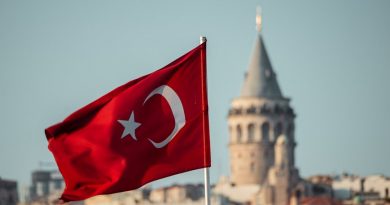Western Support for Ukraine is Sustainable and Necessary
Joshua Axton
Staff Writer
At the United Nations General Assembly this past September, Erik Mose, lead investigator for a probe into human rights violations in Ukraine, raised awareness over Russian war crimes. The state has been found responsible for “widespread attacks on civilians and infrastructure, killings, torture and rape, and other sexual violence,” reports Al Jazeera, according to the Commission of Inquiry. The commission is also investigating whether the attacks on civilian infrastructure committed throughout the conflict constitute crimes against humanity. Judge Mose’s statement at the UNGA directed concerns over Russian propaganda, stating it could be “Incitement to Genocide in Ukraine,” reports Al Jazeera. With seasons changing, U.S. Army Chief Gen Milley says that Ukraine only has “about 30 to 45 days’ worth of fighting weather left,” as they continue their advance against the Russian frontline, reports BBC News.
The Russo-Ukrainian Conflict began in 2014 with the Russian annexation of Crimea, a peninsula and critical naval base in the Black Sea for the Russian Federation, which had a lease to be stationed in Sevastopol, according to British newspaper I-news. This came after the Maidan Uprising in Ukraine, which deposed pro-Russian President Viktor Yanukovych, in support of a pro-EU government. After annexation, Russia held a referendum in Crimea whose results claimed that 96.77 percent of Crimeans desired to join the Russian Federation, but the referendum is widely regarded as illegitimate. Since 2014, Ukraine has fought Russian-backed separatists in the Donbas region of Eastern Ukraine, resulting in 14,000 deaths, reports the International Crisis Group. These self-determination groups, the Donetsk and Luhansk People’s Republics, have been utilized by Russia to legitimize their involvement under the claim that they are protecting ethnic Russians and pro-Russian Ukrainians.
On February 24, 2022, Moscow launched a full-scale invasion of Ukraine. The initial invasion aimed at a quick decapitation of the Ukrainian government by attempting to seize the capital of Ukraine, Kyiv, in the first few weeks. Many experts, including the Central Intelligence Agency (CIA), predicted the country would fall, reports The Intercept. The Russian Federation seized Kherson, the Donbas region, and at the height of the conflict in March 2022 was on the doorstep of Kyiv. Since the peak of Russian occupation, the Ukrainian government has pushed back slowly, reports The New York Times. There is pressure on Ukraine to continue making progress due to atrocities committed by the Russian Federation on Ukrainians, evidenced by torture chambers and mass graves, according to the Conflict Observatory.
This pressure is further amplified by the slowly eroding political support for Ukraine in some Western countries. Since the invasion, the EU has collectively given the country 131 billion euros of support, and the United States has given 70 billion Euros. Critical to this breakdown is 42 billion Euros from the U.S. in military aid, while more of the EU’s support has been financial and humanitarian. The United States’ contribution only comes to 0.3 percent of its GDP, while the EU mandates each member state give at least 0.5 percent of its GDP, and many are going beyond that requirement, according to the Kiel Institute.
In addition to direct aid, the EU and U.S. have imposed heavy sanctions against Russia in key sectors. Some sanctions ban transactions with Russia’s Central Bank a credit rating systems, among other areas, covering 70 percent of Russia’s banking sector. These sanctions aim to crippling Russia’s economy and its ability to finance the invasion. Others ban the import, insuring or transporting of Russian oil, along with tech and iron/steel imports and exports, reports EU Neighbours EAST. While the effects on the Russian economy are largely disappointing compared to the measures taken, they are clearly making an impact. Russian inflation is projected to be 6.5 percent this year, and Russia’s Finance Minister, Anton Siluanov says that “this year we expect it to recover by about 2.5%, maybe even more,” reports Reuters.
While data coming out of Russian state news isn’t always reliable, rising oil prices are helping fund the Russian war effort, and the Russian economy hasn’t collapsed as predicted. However, “Russia’s economy is facing a ‘slow burn” according to Robin Brooks, chief economist at the Institute of International Finance, reports ABC News. The West has implemented Price Caps at $60 per barrel for Russian oil, with the goal of reducing Russian profit while not completely banning Russian energy in the West, particularly in countries that have relied on it for a large portion of their energy needs. It is currently estimated that it only costs them $10-20 per barrel, incentivizing them to still sell, but reducing their revenue. While China and India have drastically increased imports of Russian oil and natural gas, their revenues have still decreased 49 percent from January 2021 to November 2022, reports the Centre for Economic Policy Research.
Despite economic sacrifices, European support for Ukraine remains strong. “86 percent approve of the EU continuing to provide humanitarian support to the people affected by the war, 77 percent accept welcoming in the EU people fleeing the war, and 71 percent back imposing economic sanctions against Russia.” writes EU Neighbours EAST. 65 percent of EU Citizens also support the integration of Ukraine’s market into the EU’s.
The citizens of the EU, and Europe at large, will continue to support Ukraine in almost any way but direct intervention. This is due to solidarity with Ukrainians as fellow Europeans under attack, but also fear of the Russian threat on their own borders. Ukrainian President Volodymir Zelenskyy has stated before that, “Russia was trying to annihilate ‘the Ukrainian-European way of life,’” reports The Guardian. As Russia’s population declines, its window for action is closing, and Europe is afraid of what will happen if they get through Ukraine with increasingly little left to lose. Eastern European countries like Moldova, which currently has a pro-Russian separatist enclave akin to the Donbas region in Ukraine, are particularly worried, reports The Guardian.
As far as American support for the conflict, it has largely held strong despite some erosion of support for the Ukrainian government. 40 percent of Republicans and 61 percent of Democrats “say the United States should do more to support Ukraine.” Furthermore, the “University of Maryland presented respondents with the argument that U.S. support for Ukraine was an effort to ‘uphold international law’; 92.3 percent of Democrats and 75.6 percent of Republicans found the point ‘convincing,” according to the Atlantic Council. When given arguments against sending aid to Ukraine, respondents were generally far less responsive to arguments for aid. It seems that for the time being, most Americans will support Ukrainian aid, and some want to give more for the sake of “American values,” and a fear of Russia.
As the conflict progresses, Ukraine continues to make slow but costly progress. What comes next is not fully known, but a stalemate is very likely possible. If this were to occur, it is critical that citizens in the West see victory in Ukraine as vital if they are to continue to support or further integration with Ukraine. There could be an integration of Ukraine into NATO if battle lines were to stalemate according to Charles Kupchan and Richard Haass, reports Foreign Affairs.
Critics of this idea argue that Ukraine should not join NATO because it does not have full control over all its territory. West Germany, however, was able to join NATO in 1955 despite not controlling its entire territory. While West Germany had peace with East Germany, unlike Ukraine’s situation, the idea that a country without full territorial control being accepted into NATO is not unprecedented. While widely unpopular with an active war going on, Kaja Kallas, Prime Minister of Estonia, has pushed for their membership by stating, “The only security guarantee for Ukraine is NATO membership.”New York Times) It is highly unlikely that Ukraine will join NATO until the conflict ends at the very least, but afterward, its expansion is feasible and popular. Currently, 55 percent of Americans are supportive of Ukraine joining NATO, while only 10 percent are opposed, according to Newsweek.
Even without integrating Ukraine into NATO, there have been suggestions of taking the Israeli approach to assuring security. This would mean making Ukraine so armed with Western weaponry, that it becomes far too costly or impossible for Russia to annex Ukraine. It has been described as the “hedgehog strategy,” making a country too painful to annex militarily. This is a suggestion made by former NATO Secretary-general, Anders Fogh Rasmussen. However, the key difference is that Israel has nuclear weaponry, while Ukraine gave theirs up in 1994 after the Massandra Accords, according to the Arms Control Association. To this day, Israel and the United States have no mutual defense pact, despite the mindset of an “alliance” between the two countries, because of the military aid provided to Israel by the United States. Israel, while having nuclear weapons, hasn’t lost a conventional war that would justify their use, however, their existence is a deterrence for coalitions that may form against them. Similarly, if Ukraine had nuclear weapons, Russia wouldn’t have invaded them for fear of nuclear retaliation.
The hedgehog process has already been started, with the West pumping weapons into Ukraine to help ease supply shortages. If “hedgehogging” were to continue after the resolution of the conflict, assuming Ukrainian independence endures, it is unlikely without further institutional integration into either the EU or NATO. While American public support for Ukraine has mostly held, that is because of the ongoing conflict’s severity and optimism about the impact America can have on the conflict. If the war stops trending in Ukraine’s favor in a substantial matter, American support will likely erode. Even more importantly, once the dust has settled on the conflict, Russia is projected to be a shell of its former self. There will be little incentive to support a country whose threat is no longer perceived by the West.
Despite the collapse of the Soviet Union over 30 years ago, many voting Americans are still scarred from the Cold War. 64 percent see Russia as America’s enemy, which drives support for Ukraine, according to the Pew Research Center. As the war rages on, Russia declines further. As many as 1,000,000 men have fled Russia to escape the draft, and the country’s population is projected to continue declining, according to The Washington Post. Currently, male life expectancy in Russia is 66 years, which is lower than in Syria and North Korea.
The effects of sanctions on Russia continue to hurt, even if they are working painfully slowly. As Russia continues to decline, this war becomes more meaningful, because Moscow will not have another opportunity demographically to wage a major war due to its declining population. While there has been a definite erosion of support for Ukraine in some parts of the West, the consensus is still strong enough currently for politicians to continue to support Ukraine within America, and even more so in the EU. Future integration of Ukraine is highly likely into NATO or the EU, granted Ukraine continues to maintain its sovereignty.
The longer Ukraine holds on, the better its chances of stabilizing and institutionalizing with the West. Even then, Ukraine continues making progress on its counteroffensive, which helps maintain Western support and is crucial to its continued military success. What was expected to be a swift and decisive Russian victory has turned into a heroic Ukrainian effort to maintain their costly independence and is going to continue to be so. Both sides have the resources, Russia with their oil and Ukraine with Western support, to continue fighting a war of attrition.
Image courtesy of Flickr




